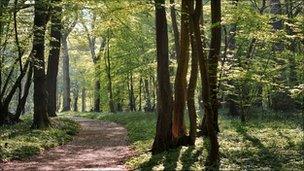Putting a price on nature
- Published
- comments
How much is a walk in the countryside really worth?
The Government has published the UK's first National Ecosystem Assessment, external today, a ground breaking report which attempts to put a cash price on the environmental services provided by nature.

Can you put a monetary value on our relationship with nature?
Services like pollination by insects, water and air purification by soils and plants, the flood alleviation provided by woods and marshes upstream of towns and cities, and even the value of living close to a green space in terms of savings to the NHS - a service the Government's bean counters put at £300 per person per year.
According to Defra's chief scientist, Dr Bob Watson, we've consistently failed to factor-in the billions of pounds these ecosystem services are worth to our economy.
"What we haven't recognised in our decision making is the value of our forests, our agricultural land, our mountains, moors and heaths. We've taken these things for granted, but what we're saying now is that we should take this hidden value more explicitly into account when it comes to decision making," he said.
Environment correspondent Richard Black has analysed the 2,000 page NEA report, but already the carping has started.
Speaking on the programme this morning the president of the Planning Officers Society, Stephen Tapper, pointed out that greenbelt land around towns is already well protected, and questioned how such pricing mechanisms would work.
"I think that's a very interesting figure [of £300 per person per year for living close to a green space], and I'd like to know how they arrived at it. We will certainly look into it, but I don't think planning decisions are ultimately going to be made on that basis".
While it's true that the National Ecosystem Assessment doesn't provide a mechanism for transferring the costs of environmental degradation onto the farmer or developer who wants to plough up a wood or concrete over a floodplain, the scientists who compiled the report say decisions about how to implement their findings should be left to legislators.
We should hear more about how that's going to happen when the government's White Paper on the Natural Environment is published next week. I'm told the NEA report has closely informed the drafting of that White Paper, and will also be incorporated into the Government's forthcoming review of planning legislation.
The Secretary of State for the Environment, Caroline Spelman, welcomed the report describing it as a vital step forward in our ability to understand the true value of nature.
"Everybody knows the wow factor when you walk into a bluebell wood, but these scientists and economists have actually managed to calculate the value of the 250-300 million day-visits to our woodlands and forests. That's worth £1.2 billion to our economy".
Understandably environmentalists are enthusiastic about the new approach. Friends of the Earth described the NEA report as "essential summer reading for all MP's and economists", while the RSPB's Director of Conservation Martin Harper said it "made a compelling case for a step change in the way we value our environment".
But there's a danger in attributing a coarse monetary value to ecosystem services: In establishing a price for everything, we may find we've learnt the value of nothing.
The view of Oxford from the top of Shotover Hill is not a tradeable commodity.
- Published2 June 2011
